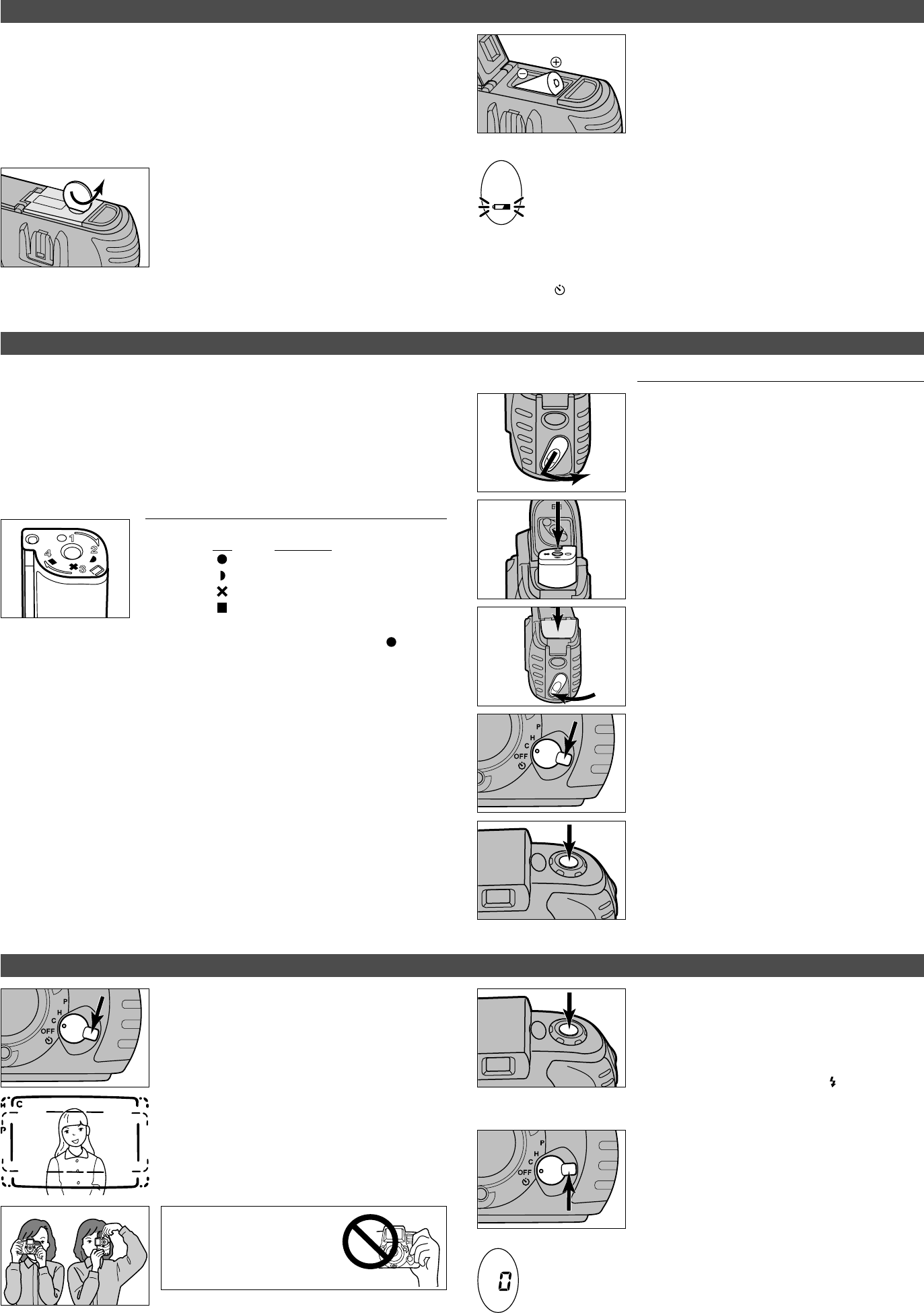
LOADING FILM
Use IX240 (Advanced Photo System) type film in this camera.
• Your camera’s transport system loads the film and advances the film after each
exposure.
• Do not open the film chamber until 0 appears or all indicators blink in the data panel.
• Install the battery before loading the film, or the film will not advance to the first frame.
• We recommend you use ISO 200 film in this camera.
Visual Exposure Indicators (VEI)
• The current VEI has a white indicator behind it.
VEI
MEANING
UNEXPOSED
PARTIALLY EXPOSED
EXPOSED
PROCESSED
• Your camera can only load unexposed film ( ).
INSTALLING THE BATTERY
1. Using a coin or similar object, turn the
battery-chamber lock to open, then open the
battery-chamber door.
2. Insert a new battery into the chamber as
indicated by the + and - marks.
3. Close the battery-chamber door and turn the
battery-chamber lock to the close position.
• Clean the rubber seals and joining surfaces before
closing covers.
TAKING PICTURES
1. Turn the command switch to the desired print
format.
Hold the camera steady, making
sure your fingers do not cover
the flash. If you are taking a
vertically framed picture, turn the
camera so the flash is on top.
Battery Warning
Replace the battery.
• If no display appears, replace the battery or make sure it is correctly installed.
• Do not remove the battery unless the battery warning blinks or no display
appears in the data panel.
• If the data panel dims after the flash fires, the battery will need to be
replaced soon.
• Your camera will shut down if it is not operated for more than three minutes.
To restore power, turn the command switch to OFF, then back to P, H, C, or
.
Loading Film
1. Turn the camera upside down, then press the
release lock and turn the film-chamber
release.
• The film-chamber door will unlock.
• Wipe dirt or moisture off of the camera and film
cassette before opening the film chamber.
2. Open the film-chamber door and insert a new
film cassette into the film chamber.
3. Press the film-chamber door closed and turn
the film-chamber release to the lock position.
• The film cassette may be damaged if the film-chamber
release is moved when the film-chamber door is open.
4. Turn the command switch to C, H, or P.
5. Press the shutter-release button.
• The film will advance to the first frame.
• The frame counter displays the number of exposures
remaining on the roll.
• If all indicators blink in the data panel, the film has not
loaded. Remove and reload the film cassette.
2. Frame your subject(s) in the image frame for
the selected print format.
3. Press the shutter-release button to take the
picture.
• Keep your subject at least 1.0m (3.3 ft.) from the
camera.
• With ISO 200 film, the flash has a range of 1.0 – 3.0m
(3.3 – 9.8 ft.) and will fire when necessary.
• You can’t take a flash picture when blinks in the
data panel (flash charging).
4. Turn the command switch to off when the
camera is not in use.
After the last exposure is taken, “0” will appear in the data panel.
When the motor stops, open the film chamber and remove the film.
• Remove your film immediately after rewinding. Film left in the camera may
reload causing double exposures.
Your camera uses one 3-volt CR2 lithium battery to supply power for all camera
operations. Please read the warnings in the Safety Cautions section of this manual
as well as those supplied by the battery manufacturer.
• If film is in the camera when the battery is replaced, install a new battery immediately
after removing the old battery. If the battery is not replaced immediately, your camera
may advance one frame and display - - in the frame counter for the remaining
exposures. The frame counter will return to normal operation when a new film cassette
is loaded.






